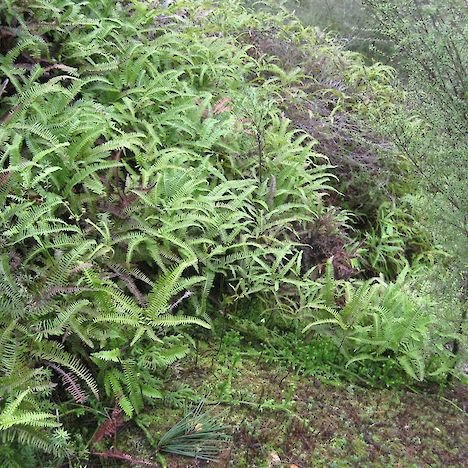Threat category:
Threatened: Nationally Endangered?Regions:
Waikato, Bay of PlentyDistribution:
Geothermal habitat within the Taupo Volcanic Zone
Key Features
- Dicranopteris linearis is a distinctive fern and the only species from this genus in New Zealand.
- It is a terrestrial fern with long creeping rhizomes, with stipes 55-960 mm long and fronds 140-1,220 mm long.
- It is most likely to be confused with species of Gleichenia and Sticherus, which are the other genera in the family Gleicheniaceae found in New Zealand. It is differentiated from these species by β costae lacking costal segments (see Perrie and Brownsey 2015).
Distribution and Habitat
- In New Zealand, Dicranopteris linearis is confined to geothermal habitat within the Taupo Volcanic Zone in the Waikato and Bay of Plenty regions from near sea level to c.500 metres above sea level.
- It is most abundant in geothermal kānuka (Kunzea tenuicaulis) scrub and shrubland, often associated with other ferns, but can extend into mixed broadleaved species forest and scrub habitat on geothermal margins.
- D. linearis is known from c.23 geothermal sites, although 12 of these populations are very small. It can be locally common.
- This species is also widespread outside of New Zealand in tropical regions of Africa, Asia, New Guinea, Australia, and the Pacific Islands (Perrie and Brownsey 2015).
Threats
- Many populations are very small and therefore vulnerable to extinction. However, other populations are relatively large and are not threatened if geothermal systems and associated vegetation are protected.
- Loss of geothermal habitat as a result of energy extraction or change in land use e.g. farming.
- Pest plant invasion, particularly blackberry on geothermal margins at many sites.
- Vegetation succession.
- Habitat loss and modification.
- Potentially introduced weeds tolerant of heated soils.
Management Opportunities
- Protect habitat.
- Monitor population demographics (size, growth, density, distribution) over time. Some populations may be monitored using photopoints (photographs should be retaken at same time of year, and preferably in summer).
- Ensure that forest owners are aware of potential habitats and can recognise the species.
- Survey geothermal areas to assess botanical values present and provide information to landowners.
Monitoring Options
- Check existing populations on a regular basis, either by direct monitoring or photopoints.
- Report new locations to DOC.
- Further Information and Support
- Weed control - Department of Conservation, Regional Councils.
References
- Brownsey P.J. & Smith-Dodsworth J.C. (2000). New Zealand Ferns and Allied Plants. David Bateman, Auckland.
- Perrie L.R. & Brownsey P.J. (2015). Gleicheniaceae . In: Breitwieser, I.; Heenan, P.B.; Wilton, A.D. Flora of New Zealand - Ferns and Lycophytes. Fascicle 12. Manaaki Whenua Press, Lincoln. http://dx.doi.org/10.7931/B1VC77
- New Zealand Plant Conservation Network (NZPCN). http://www.nzpcn.org.nz
- Wilson C.M. & Given D.R. (1989). Threatened plants of New Zealand. DSIR Publishing, Wellington.



